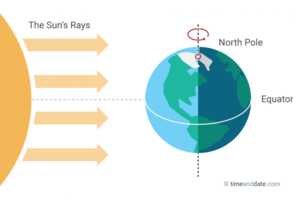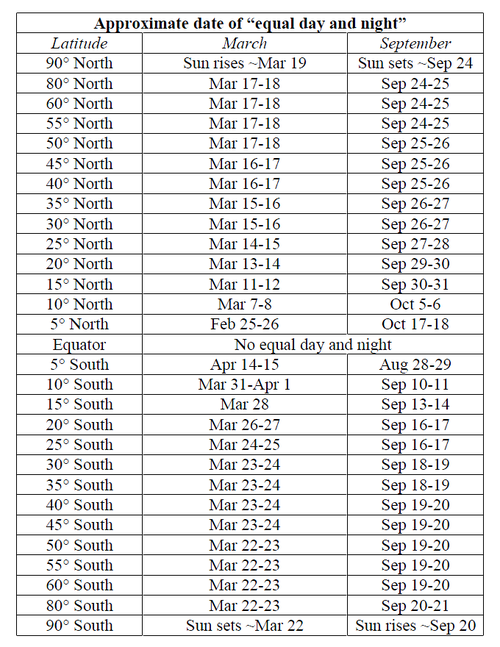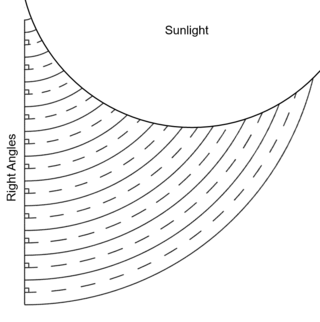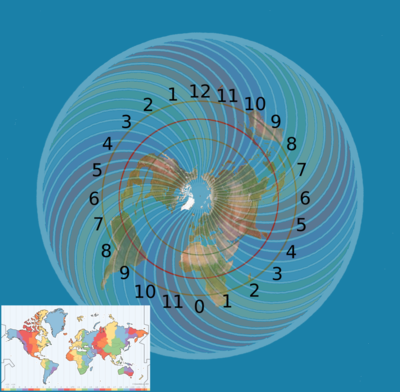Equinox
The Equinox is the day where the sun passes directly over the equator in its Northward and Southward movements between the Tropic of Cancer and the Tropic of Capricorn. This topic is often used in discussions as evidence in favor of a Round Earth. Round Earth proponents have popularly made two claims for this day:
- The sun will rise from the East on this day for all locations on earth
- The earth will experience equal times of day and night
We find, however, both of these claims to be untrue.
The sun does not rise from the East for all locations on earth. It is admitted by academia that the sun is often displaced by, as an example from one particular location, several sun diameters from East on this day, with an allegation that it is only from the equator where the sun rises from the East.
Further, it is admitted by academia that equal times of day and night do not occur for this day all over the earth. The day of equal day and night is location and time specific. The period of equal day and night does not occur until several days after or before the equinox and, for some locations, the period of equal day and night does not occur for a time period measured in weeks away from the day of the equinox.
Finally, the Equinox under Flat Earth Theory is discussed in the section A Flat Earth Equinox.
Dictionary Definition
Oxford Dictionary defines the Equinox as (Archive):
equinox/ˈɛkwɪnɒks//ˈiːkwɪnɒks/
noun
"The time or date (twice each year) at which the sun crosses the celestial equator, when day and night are of equal length (about 22 September and 20 March)."
Origin
Late Middle English: from Old French equinoxe or Latin aequinoctium, from aequi- ‘equal’ + nox, noct- ‘night’.
Myth I: Direction of Sunrise and Sunset
The Claim
It is claimed that the sun rises from due East for everywhere on earth. From the astronomy website earthsky.org we read the following (Archive):
“ Does the equinox sun really rise due East and set due West?
The March equinox signals spring in the Northern Hemisphere and autumn in the Southern Hemisphere. On this day, the sun rises due East and sets due West.
It may seem counterintuitive. But it’s true no matter where you live on Earth. ”
Equinox Sunrise Not from the East
From The Permaculture Research Institute (Archive) we read the following:
“ Why is the equinox important for permaculture?
One of the first questions my PDC instructor posed to us was, “where does the sun rise?" Well everyone knows the answer to that; the sun rises in the East. No brainer. Alas, we were wrong. Unless you live at the equator, the sun does not rise directly in the East. ”
Russel D. Sampson of the University of Alberta informs us that the sun does not actually rise due East on the equinox, and is displaced from the East by multiple sun-diameters:
Astronomical Refraction and the Equinox Sunrise (Archive)
“ The original motivation for this paper was the Journal article by Attas & McMurry (1999) entitled “Nailing the Equinox Sunrise.” In the article it is stated that “on the equinox, the Sun should rise due East.” Since the Sun crosses the celestial equator at the equinox, and since the celestial equator crosses the horizon at 90º and 180º azimuth (due east and west), that statement appears on the surface to be correct. Once the effects of astronomical refraction are considered, however, the phenomenon becomes a little more complex.
...In this paper the unrefracted Sun is referred to as the geometric Sun. From the definition of sunrise and sunset, the azimuthal location of the geometric equinox sunrise can be shown to be less than 90º (north of due East in the northern hemisphere). The magnitude of the difference depends on the observer’s latitude and the apparent diameter of the Sun (see figure 2). From figure 2 it is apparent that the only location where the equinox sunrise occurs exactly at the East point is on the equator. ”
We note that, while the failure of this prediction to meet reality is acknowledged, and remarks to the nature of 'only at the equator' are given, no observations of the sun at the equator are actually referenced.
Myth II: Equal Day and Night
The Claim
It is claimed that this day is a special day which receives equal day and night. The very name equinox, indeed, means 'equal day and night'.
This myth is prevalent at many institutes. From the Oklahoma Climatological Survey (Archive) we read:
“ During the equinoxes (March 21 and September 21), a day lasts 12 hours and a night lasts 12 hours at all latitudes. ”
Approximate Date of "Equal Day and Night"
Ancient Observatories - Timeless Knowledge
by Deborah Scherrer, Stanford Solar Center
Link to Paper
In 2015 Deborah Scherrer of the Stanford Solar Center provided a document titled "Ancient Observatories - Timeless Knowledge." On page 39 we see the following:
“ Calculating the Equinoxes
Most dictionaries erroneously define the equinox as: “the time or date (twice each year) at which the Sun crosses the celestial equator, when day and night are of equal length (about September 22 and March 20)”. However, there is no place on Earth where the day and night are of equal length on the given days.
Latitude Determines Day Length
In fact, latitude determines day length. Even if day and night aren’t exactly equal on the day of the equinox, there are days when day and night are both very close to 12 hours. However, this date depends on the location’s latitude, and can vary by as much as several weeks. The table shows approximate dates for when day and night are as similar as possible according to latitude. ”
The falsity of the claim is acknowledged by the above. For further research purposes, it is unfortunately not referenced from which longitudes this information was gathered from.
As with much else in the model, the refraction argument is used as a sweeping rebuttal to anyone who sees the sun for longer than it should be, shorter than it should be, or as a rebuttal to anyone who sees it rise from a location where it should not rise from. When it comes to specific assertions, the Round Earth model is unable to be justified with a prediction that fits reality.
A Flat Earth Equinox
Eastern Sunrise
Q. How can the sun rise from even within two degrees of Due East in the Flat Earth model (Monopole)?
A. This is a popular topic point, but is based on a common misconception. The top down views of the Flat Earth sun models might imply that the observer can see infinitely across the earth, and see the sun at all times. However, we cannot see infinitely into the distance. The distance to the horizon is limited to a very finite circle around us. We cannot see that far. The distance to the horizon is limited by the thickness of the atmolayer (or other variables). The atmolayer is not perfectly transparent. At night when we look out at where the sun would be across the plane of the earth we are looking into hundreds of miles of fog, and thus the sun is dark and unseen.
Beneath and around the sun is a circular area of light, which represents day. According to the FET the sun we see is a projection upon the semi-transparent medium of the atmolayer which exists all around us. The Sun is projected onto a medium in transition, much like a projector shines upon a movie screen, a hologram on mist, or a page's text on a magnifying glass. When shining a laser pointer at a sheet of paper, for example, it creates a projection of the dot onto the paper which could be seen on the opposite side of the paper. The sun is projecting its image upon the thickness of the atmolayer around it (see Magnification of the Sun at Sunset for further information). This image of the sun upon the atmolayer has been colloquially termed the apparent sun. Along the edges of the sun's circular area of light is sunrise. When the circle of the sun's light intersects with the observer's personal circle, or "dome", of vision, sunrise will occur for that observer.
During Equinox the sun is over the equator, with its circular area of light pivoting around the point of the North Pole. The points on the edge of the sun's circular area of light are tracing along the latitude lines, the time of the Equinox being a circle pivoting around itself.
Further, the circular latitude of the equator is very large, and if one were to zoom into a segment of that circle, down to human standards of an observer's small circle of vision, down to a town/personal scale, the curve of the equator beneath the observer would straighten out. The latitude line beneath you locally is relatively straight. When the edge of the sun's area of light intersects the observer's circle of vision it will approach from the East, or near the East. The apparent sun at sunrise is on the rim of the sun's area of light and is racing upon the atmolayer along the observer's latitude line to the observer. However straight the observer's latitude line is in his or her local area where the observer can see will be how close to East the sun will appear in its initial bearing.
Consider the following:
- If there was a race car (or jet ski) racing along the surface of the earth towards you on your circular latitude line, and you only see it when it is nearby, would you see it from the East or very near the East? If so, then that is the answer.
Q. According to FET the sun is perhaps 3000 miles high, and is unlike a race car or a jet ski. How is this answer applicable?
A. The sun that we see is a projection on the atmolayer. Its image is close to the earth. We cannot see through all of the atmolayer at once, only out to perhaps 30 miles at elevations near sea level. When we look at the sun at sunrise, we are seeing its nearby projection which intersects and appears on our dome of vision that represents our limits of sight. A cloud traveling around your latitude line towards you would also appear from the East when it appears, just like a jet ski or a race car would. Hence, the analogy is directly applicable. If clouds, jet skis, and race cars would appear from the East to our limited range of vision, as could the sun's nearby projection.
Bi-Polar Model
The Bi-Polar model features a similar explanation for Eastern sunrise. During Equinox the edges of the sun's area of light are tracing along the latitude lines as they approach the observer, generally approaching the observer from an Eastward direction.
Simultaneous Sunrise on Longitude Lines
Q. If the above were true, it would imply that the Sun rises at different times for different observers located on different places on a North-South longitude line which radiates outwards from the North. Yet, we know that on Equinox the Sun rises from the East at the same time for all observers on the same longitude line simultaneously. A direct interpretation of RE to an FE Monopole Model with straight radial longitude lines would show the following:
A. The longitude lines were historically determined in relationship to the local time of day1. Applying the original interpretation of longitude to a Flat Earth Monopole Model with a curved area of daylight would show that the longitude lines, and time zones, are curved:
Points in a line radial from the North are not necessarily on the same longitude line. If longitude is defined by local time and time zones then sunrise can occur for all observers simultaneously on the same longitude.
Footnotes
- 1 See any history on the origin and determination of the Longitude. On p.90 of Chronicling the Golden Age of Astronomy, it states "There is a direct relationship between time and longitude. If the navigator knew the time at a fixed reference point when some event occurred at the ship's location, the difference between the reference time and the apparent local time would give the ship's position relative to the fixed location."
See Also
Sunrise and Sunset - Sunrise and Sunset Main Page
- Electromagnetic Acceleration describes the rising and setting of the Sun, as well as several other phenomena
- The Setting of the Sun as a Perspective Effect describes the traditional interpretation of sunsets as originally described by Samuel Rowbotham
- Magnification of the Sun at Sunset describes why the Sun does not shrink as it recedes
- The Equinox page describes why the Sun rises and sets from a generally Eastward and Westward direction





